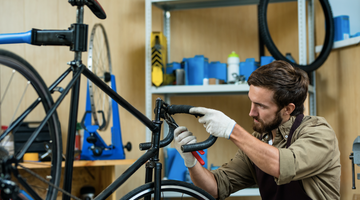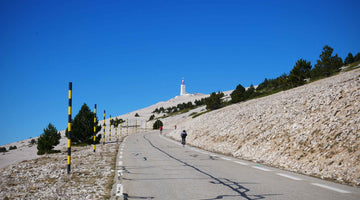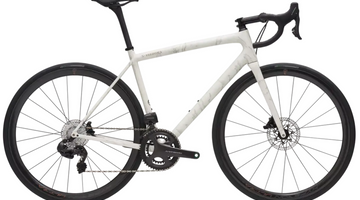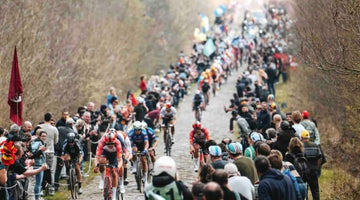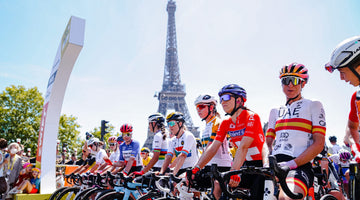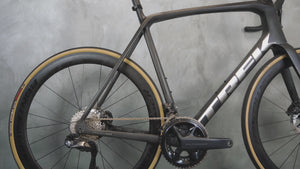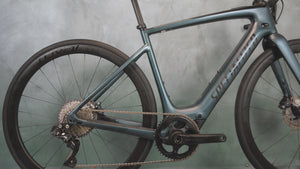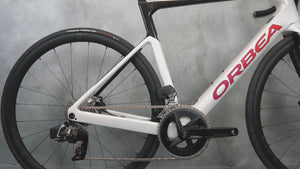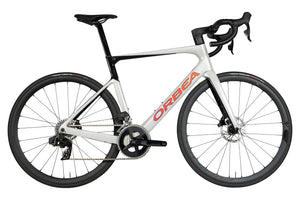Aero bike, climber or endurance: which category to choose?
Posted on April 29, 2022
Although some brands like Specialized simplify their range of road bikes (fusion of Tarmac and Avenge models), for the vast majority of manufacturers, the trend is to the production of increasingly specific bikes, adapted to each type of profile and ground.
You have probably noticed it, browsing the website of a bicycle manufacturer, you will quickly have to choose between three separate categories: light/climber, aero and endurance.
But how do you find your way around? Are these categories so distinct from each other? Is it impossible to use an endurance bike for climbs or a light bike to go fast?
We have dissected the subtleties of each category to allow you to better understand what makes them suitable for specific use. To highlight these differences, we took the example of the three flagship models from Cannondale: Systemsix (aero), Supersix (light/climber) and Synapse (Endurance).
Aero bike
Who is this type of bicycle for? Short distance triathletes.
main Features : Aggressive geometry, aerodynamic tube profiles, deep section wheels.
Disadvantages : Comfort is generally sacrificed in favor of speed, weight and performance in the back wind.

Aggressive geometry
The main priority of aerodynamic bikes is to reduce drag and be as comfortable as possible in the wind. 85 % of the resistance that a cyclist must overcome comes from himself, it is therefore logical to reduce the frontal profile of the cyclist as much as possible. Consequently, the aerodynamic bicycle management socket is short, which reduces the frontal profile and the resistance to overcome. As a rule, the steering socket of an average aerodynamic bike will be less than 140 mm, unlike that of an endurance bike which will be greater than 160 mm.
In combination with a short steering tube, aerodynamic bikes will have a longer reach than endurance bikes. Reach is measured horizontally between the center of the pedal axis and the steering tube. Reach of the frame gives a good overview of the main use of a bicycle.
For example, the Systemsix, the aerodynamic bike of Cannondale, has a 39.2 cm reach in size 56, while the synapse, intended for endurance, has a 38.7 cm reach in the same size. The two measures are taken from a 56 cm frame, stressing that the aerodynamic bikes aim to lengthen the cyclist, while the endurance bikes aim to place the cyclist in a further position.
It is important to recognize the difference between Reach and the scope of the cyclist. The scope of a cyclist is measured from the tip of the saddle in the center of the handlebars. Unlike Reach, the scope of a cyclist can be modified by a longer stem or a greater decline in the saddle. By modifying the scope of a cyclist, a bicycle oriented towards endurance can be closer to the geometry of an aerodynamic bicycle and vice versa. However, this approach has its limits. The more you handle and move away from the planned geometry of the bicycle, the less likely it is to work as expected.

The disadvantage of the aggressive geometry of aerodynamic bikes is that many cyclists do not have the flexibility necessary to reach the planned position or force to maintain this position for long periods. If you are not flexible enough to adopt this low position, the aerodynamic advantages will be lost. And if you force yourself to adopt this position, you may hurt yourself.
Aero Dynamics
The objective of the profile of the tubes of an aero bicycle is to minimize the drag and to be as comfortable as possible in the wind. To do this, the tube profiles are long, thick and profiled, with an tapered attack edge.
The general form of aerodynamic frames is aggressive and angular. Aerodynamic bikes generally have a straight and flat upper tube, unlike light and endurance bikes which generally have an inclined upper tube to add flexibility. The upper right tube improves rigidity and reduces the front profile of the bicycle. Endurance bikes and light bikes often have long saddle tubes to allow a certain flexibility and offer additional comfort.

The additional material required for aerodynamic tubes increases the weight of the bicycle, which makes the aerodynamic bikes heavier.
Integration is a key element of aerodynamic bikes. It is sometimes difficult to know where the brakes of an aerodynamic bike are because they are hidden. On many aerodynamic bikes, the rear brake is hidden from the wind under the pedal box or using ingenious creations like the "wings" from Trek. It is also common to see "cutouts" on the shrouds, the saddle tube or the fork in order to integrate the brake into the bicycle in an invisible way.
It is rare to see cables on aerodynamic bikes, because they are largely hidden by orifices in the frame, and the hanging/soup combinations have become common to improve not only aerodynamics but also the rigidity of the cockpit.
The deep section wheels constitute the last piece of the puzzle. Aero bikes will always be associated with deep section wheels to further reduce drag and improve aerodynamics. In general, these wheels have a depth of at least 40 mm, sometimes up to 80 mm. The disadvantage of deep profile wheels is the additional weight and potentially difficult handling in windy conditions.
Big speed reports
This characteristic is not universal on aerodynamic bikes, but it is more common than other bikes. Aerodynamic bikes were created to go fast, so it makes sense that their speed reports are larger.

Traditionally, road bikes are equipped with a large 53 teeth tray and a small 39 -teeth tray on the front pedal. Most bikes have evolved towards a "semi-compact" pedals, with a large 52-teeth tray and a small 36-teeth tray, or a "compact" pedals with a large 50 teeth tray and a small 34-teeth tray . Smaller relationships create easy -to -handle gears, perfect for slower speeds or climbs. As aerodynamic bikes have not been designed for one or the other of these two activities, they are often equipped with a traditional 53/39 crankset for high speeds on flat roads. The rear cassette ratio completes the need for speed. A 11-25 cassette is generally used to ensure a smooth speed change and less significant speed jumps.
Most entry -level bikes and intermediate ranges sold to the public are equipped with a compact configuration, because most of us do not reach the speeds of professional runners and therefore do not need the biggest reports.
Light bike / climber
Who is this type of bicycle for? Cyclists who like to climb and versatile cyclists.
Specific characteristics : Light, versatile.
Disadvantages : Is located halfway between the speed of an aero bike and the comfort of an endurance bike.

Lightness
As its name suggests, the objective of light bikes is to obtain the lightest possible bike.
For this case study, we had the Cannondale Systemsix, Supersix and Synapse, all with the same specifications. The difference in weight was considerable. The supersix was the lightest with a weight of 7.6 kg, the slightly heavier system with its 7.9 kg and the much heavier synapse with its 9.5 kg. Almost 2 kg of difference between Supersix and Synapse, with similar components and in the same size. A large part of this difference in weight is due to the frame itself.
Versatility
Light bikes tend to be somewhere in the midst of the performance of aero and endurance bikes, making it the choice of versatile runners. They are not as comfortable as an endurance bike, but generally more than a aerodynamic bike. They are not as rigid as a aero bike, but more rigid than endurance bikes. The handling is much more precise than that of an endurance bike and comparable to that of an aero bike, although it is even more agile thanks to the reduced weight.
The profiles of the light bike tubes are as thin as possible without compromising rigidity or sustainability too much. The finest tubes make it possible to reduce the weight while allowing a slight bending, which reduces road vibrations and makes driving more comfortable. To find the balance between weight and rigidity, the light frames aim to improve the resistance and rigidity of the pedals, the saddle tube, the steering tube and the bases using different types of carbon or by placing more fibers.

Light bikes may not be as rigid as aerodynamic bikes, but their rigidity/weight ratio is much better. The profiles of the tubes of aero bikes are much wider and thick, which makes them incredibly rigid, but this additional material, associated with other characteristics, makes them heavy. Light bikes offer similar rigidity, but are much heavy.
Geometry
The geometry of light bikes tends to vary from one manufacturer to another, depending on the range of bikes offered. Some manufacturers who offer aerodynamic, endurance and light bikes can modify geometry to make it more aggressive, because they have an endurance bike as an alternative, while other manufacturers can create more "relaxed" geometry For their light bike, because they do not have this luxury. As we mentioned above, light bikes are versatile bikes and their geometry can therefore vary considerably.
Endurance bike
Who is this type of bike intended for? Long distance runners, those who drive on damaged roads, the vast majority of runners.
Specific characteristics : Comfort, right driving position, durability.
Disadvantages : Weight penalty, less agile handling.

Comfort and stability
Endurance bikes must be comfortable, robust and durable. They were first created for the races on cobblestones in northern France. These races last all day and take place at high speed on bumpy roads. In an attempt to eliminate fatigue caused to runners by road vibrations, endurance bikes were created to allow the use of wider tires. Larger tires can operate at lower pressure than finer tires, which reduces road vibrations and allows you to ride smoothly.

Geometry
Unlike aerodynamic bikes, endurance bikes aim to place the cyclist in a further position. The steering socket and the wheelbase are longer, the Reach is reduced and the height of the frame is increased.
Systemsix / synapse comparison for a 56 cm frame:
- steering socket: 14.9 cm / 16.4 cm
- wheelbase: 98.7 cm / 99.8 cm
- Reach: 39.2 cm / 38.7 cm
- Stack: 56 cm / 59 cm
This combination creates a less aggressive positioning, allowing cyclists to more easily cover long distances without putting too much tension in their back, their shoulders, their necks and their hamstrings. The positioning requires less flexibility. The front profile of the runner is wider in this position, which means that it "catches" more wind and must overcome greater resistance, but comfort takes precedence over the speed in the duration and in this more comfortable position, a runner can be able to produce more power for longer, thus obtaining a better result than by trying to adopt an uncomfortable and too aggressive position.
Associated with wider tires, the elongated wheelbase increases the stability of the bicycle. A wider handlebar also contributes to the stability of endurance bikes. Endurance bikes generally have a 44 cm or 46 cm handlebar, compared to 40 cm or 42 cm for aero and light bikes. The larger the frame of a bike, the more the size of the handlebars increases, because it is assumed that a larger cyclist uses it, but whatever the size of the frame, you can expect the handlebar of A endurance bike is 2 cm wider than that of an aero or light bike, whatever its size.

The angle of the steering socket of a bicycle changes the sensation and the behavior of the bicycle. A pronounced angle will result in a more reactive conduct, while a less marked angle will create a more "relaxed" driving, making the bike easier to handle.
Long distances
As their name suggests, endurance bikes are designed for long distances. We talked about comfortable geometry and integrated flexibility, but there are some other characteristics that allow the bicycle and the cyclist to hold the whole day, whatever the weather conditions.
Endurance bikes are almost always equipped with a "compact" front pedal with a large -speed cassette. This configuration allows you to pedal easily and is small enough to overcome steep slopes or tired legs at the end of a long day. The rear cassette is generally 11-28 or 11-32, and when associated with a pedal before 50/34, it is sufficient to overcome any race profile.

CONCLUSION
If you hesitate between these three categories of road bikes and you cannot make a decision, comfort and sustainability should be the priorities for the majority of runners who do not participate in races. The relaxed geometry and the robust nature of the endurance bikes should place them in first position for most people, especially if you like long outings or you start. If you plan to participate in races, if you like shorter outings or if you are already comfortable with more elongated positions, you will have to choose between the light option and the aerodynamic option. For winding roads, montages and moderate speeds, prefer the versatility of a light bicycle. For the crazy and speed crazy, the aero obviously presents itself as the best option.
Finally, if your budget allows, it remains the option to have a bike in each category!






